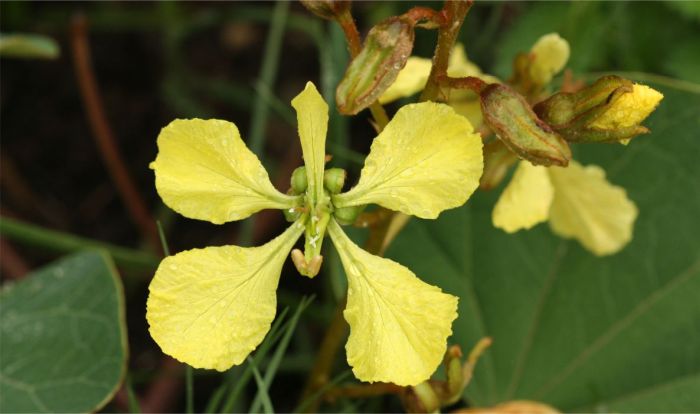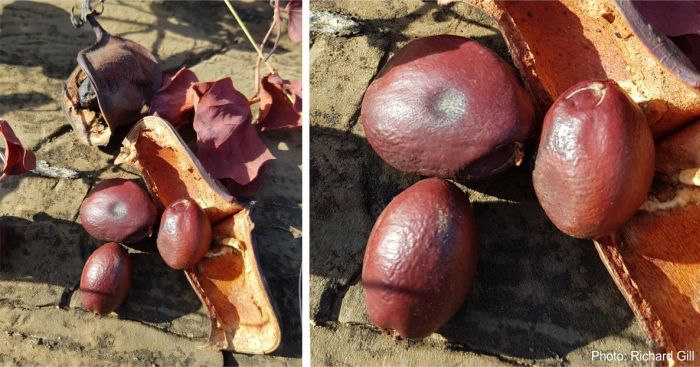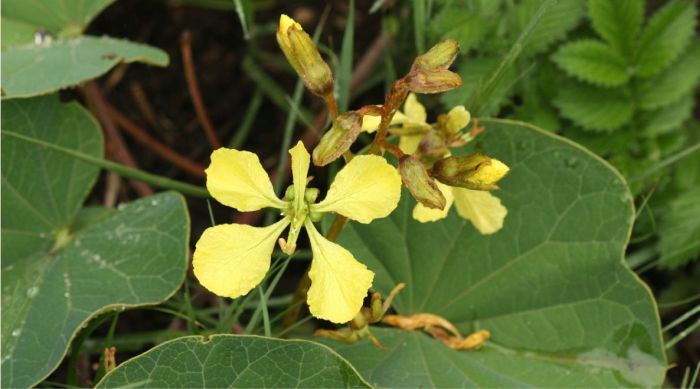Tylosema esculentum
Tylosema esculentum (Burch.) A.Schreib.
Family: Fabaceae
Common names: gemsbok bean, marama bean, camel’s foot (Eng.); braaiboontjie, gemsbokboontjie, kastaingboontjie (Afr.)
Introduction
Tylosema esculentum is a long-lived, underutilized, drought-tolerant, perennial legume that grows wild on the arid and semi-arid grasslands of southern Africa. This plant has attractive yellow flowers and large edible seeds that serve as a source of nutrition in Africa.

Fig. 1. A typical flower of Tylosema esculentum with four large petals and one narrower petal.
Description
Description
Tylosema esculentum is a trailing, herbaceous perennial, with a tuberous root and red to grey, pubescent stems that become hairless with age. The bases of the stems tend to become woody and the stems can trail across several metres. Tylosema esculentum has forked, thread-like tendrils, 10–40 mm long, that are possibly used for support when trailing over other vegetation, although this hasn’t formally been documented yet. The stipules are 3–5 mm long and elliptic-oblong to obovate. Petiole length ranges between 15–35 mm. The leaf blade size varies between 30–75 mm in length and 40–100 mm in width and is cordate (heart-shaped) at the base, bilobed for half of its length or more, and the lobes reniform (kidney-shaped).

Fig. 2 Tylosema esculentum has bilobed leaves with heart-shaped bases.
Tylosema esculentum has racemose inflorescences (flowerheads) that are 40–120 mm long with 8–20 flowers, borne on 20–45 mm long stalks. Each flower is subtended by a bract (a specialized leaf-like structure associated with flowers), 3–4 mm in length and linear-lanceolate in shape, and two bracteoles, a little smaller than the bracts, that are placed on the flower stalk. The calyx lobes are 8–12 mm long, oblong-lanceolate, hairy and tapered towards the tips with the upper 2 lobes fused. The corolla consists of 5 yellow petals, 4 large and 1 narrower, 15–25 mm long, obovate, slightly crinkled, and borne on long claws. Filaments of fertile stamens are 10–12 mm long, and those of staminodes (sterile stamens) 3–6 mm long. The ovary is 5–6 mm long and glabrous. The pods are 50–90 mm long and 45–65 mm wide, ovate-oblong, borne on short stalks and reddish in colour, turning brown with age. The seeds are relatively large, 13–20 mm long and 12–18 mm wide, ovoid (egg-shaped) to subspherical, brown to brownish-black, with a hard seed coat able to resist mechanical damage.

Fig. 3. An inflorescence of Tylosema esculentum, and a close-up of a flower.
Conservation Status
Status
Tylosema esculentum is widespread and not in danger of extinction. According to the Red List of South African Plants, the conservation status of this species is Least Concern (LC).
Distribution and habitat
Distribution description
Tylosema esculentum occurs across the northern parts of southern Africa, in South Africa, Namibia and Botswana and extending into Angola and Zimbabwe. In South Africa, T. esculentum is found in northern Gauteng, Limpopo, North West and the Northern Cape. It is localized in patches of grassland and wooded grassland vegetation in sandy and limestone (including dolomite) soils, but not on soils developed over granite or basalt. All species of Tylosema are found from low to moderate altitudes.
Derivation of name and historical aspects
History
The name Tylosema is of Greek origin, from tylos, meaning ‘knob’ or ‘lump’ and sema, meaning ‘sign’ or ‘mark’, because the seeds typically have a u-shaped mark on them. The name esculentum is of Latin origin and means ‘edible, fit for food, to be eaten’. As the name suggests, marama beans are edible and nutritious.
The genus Tylosema has five accepted species, namely: T. angolense, T. argenteum, T. esculentum, T. fassoglense and T. humifusum and occurs in southern and eastern Africa. However, some taxonomists do not consider Tylosema to be a separate genus, but include it in Bauhinia. Synonyms for T. esculentum are: Bauhinia bainesii, Bauhinia burkeana, Bauhinia esculenta and Phanera burkeana.

Fig. 4. Pods and seeds of Tylosema esculentum showing the u-shaped mark on the seeds. (Photo: Richard Gill)
Ecology
Ecology
Tylosema esculentum flowers are pollinated by insects. The arrangement of the staminodes and anthers surrounding the style assists in directing potential pollinators to the correct position for legitimate pollen transfer. Insect activity around T. esculentum has been observed to be low even during the peak of the flowering season. Ants have been suggested to be the main pollinators of T. esculentum, but they could also be robbers of nectar rather than pollinators. The abundance of flowers in T. esculentum has also been suggested to be a reward mechanism for attracting scarce pollinators.
The stems die back at the end of the summer growing season, and the tuber becomes dormant during the dry, cold winter, resprouting in spring, when the warm, rainy weather returns. Tylosema esculentum is drought-tolerant, and is able to survive periods of drought because it can draw on water reserves stored in the tuber, and it can close its leaves and stomata to reduce the exposed leaf area and prevent water loss.

Fig. 5. A top view of a Tylosema esculentum flower-head showing the size of the flowers in relation to the leaves.
Uses
Use
The seeds and tubers of Tylosema esculentum are edible, nutritious and a palatable food source that are collected and consumed locally. The marama bean is highly nutritious when cooked and has a high protein content (32%), which is almost equivalent to that of soya beans (38–40%). The oil content in marama bean is 36–43% of the dry seed by weight, which is approximately twice the amount of oil found in soya beans, almost approaching that of peanut oil. The nutritional content of marama bean is generally higher than that of other legumes. The transparent oil from the seeds is edible with the consistency and taste similar to that of almond oil. When cooked or roasted, T. esculentum seeds exude a nutty flavour like that of coffee beans or roasted cashew nuts. The seeds can also be cooked with maize, ground to flour or used to prepare warm beverages like coffee or hot chocolate. The oil is also used in the preparation of cosmetics.
This plant is not often farmed for its edible seeds and tubers, but it could be used more widely and become a valuable crop, particularly in arid and semi-arid regions, where it is naturally adapted to grow.
Growing Tylosema esculentum
Grow
Propagation of Tylosema esculentum is done by seed and has a relatively high germination and emergence percentage, confirming that marama bean seeds have no physiological dormancy. However, scarification of T. esculentum seeds has been shown to improve germination but the seeds should not be pre-soaked. Germination starts to take place after approximately 9 days. Once germinated, the seedlings develop rapidly.
Grow Tylosema esculentum in well-drained, sandy, compost-enriched soil in full sun, and water well in spring and summer. It is well suited to water-wise grassland gardens, and an interesting addition to food gardens.
References
- Allen, O.N. & Allen, E.K. 1981. The Leguminosae, a source book of characteristics, uses & nodulation. University of Wisconsin Press.
- Bower, N., Hertel, K., Oh, J. & Storey, R. 1988. Nutritional evaluation of marama bean (Tylosema esculentum, Fabaceae): Analysis of the seed. Economic Botany 42(4): 533–540.
- Brummitt, R.K., Chikuni, A.C., Lock, J.M. & Polhill, R.M. 2007. Leguminosae subfamily Caesalpinioideae. In: J.R. Timberlake, G.V. Pope, R.M. Polhill & E.S. Martins (eds). Flora Zambesiaca 3(2): 1–218. Royal Botanic Gardens, Kew.
- Castro, S., Silveira, P., Coutinho, A.P. & Figueiredo, E. 2005. Systematic studies in Tylosema (Leguminosae). Botanical Journal of the Linnean Society 147(1): 99–115.
- Coetzer, L.A. & Ross, J.H. 1977. Tylosema. In: B. De Winter, D.J.B. Killick, O.A. Leistner & J.H. Ross (eds). Flora of southern Africa 16(2): 61–64. Botanical Research Institute, Pretoria.
- Facciola. S. 1998. Cornucopia II, a source book of edible plants. Kampong Publications, California.
- Germishuizen, G. & Meyer, N.L. (eds) 2003. Plants of southern Africa: an annotated checklist. Strelitzia 14. National Botanical Institute, Pretoria.
- Gill, R. 2019. Observation of Tylosema esculentum on iNaturalist. https://www.inaturalist.org/observations/35323396. Acccessed 23/02/22.
- Hartley, M.L. 2002. Functional heterostyly in Tylosema esculentum (Caesalpinioideae). Annals of Botany 89: 67–76.
- Jackson, W.P.U. 1990. Origins and meanings of names of South African plant genera. University of Cape Town.
- National Research Council of the National Academies. 2006. Lost Crops of Africa: Volume II: Vegetables. Chapter 13: Marama. The National Academies Press, Washington D. C. Page 234. DOI 10.17226/11763.
- Raimondo, D., Von Staden, L., Foden, W., Victor, J.E., Helme, N.A., Turner, R.C., Kamundi, D.A. & Manyama, P.A. (eds) 2009. Red list of South African plants. Strelitzia 25. South African National Biodiversity Institute, Pretoria.
- Travlos, I.S., Economou, G., & Karamanos, A.I. 2007. Germination and emergence of the hard seed coated Tylosema esculentum (Burch.) A.Schreib in response to different pre-sowing seed treatments. Journal of Arid Environments 68(3): 501–507.
- Van der Maesen, L. J. G. 2006. Tylosema esculentum (Burch.) A.Schreib. PROTA, 1. https://uses.plantnet-project.org/en/Tylosema_esculentum_(PROTA).
Credits
Thembeka Malwane
MSBP Seed Processing Coordinator
and Marianne le Roux
National Herbarium, Pretoria
March 2022
Acknowledgements: the image of pods and seeds (Fig. 4.) by Richard Gill, all other images by the authors.
Plant Attributes:
Plant Type: Ground Cover, Perennial
SA Distribution: Gauteng, Limpopo, North West, Northern Cape
Soil type: Sandy, Loam
Flowering season: Early Summer, Late Summer
PH:
Flower colour: Yellow
Aspect: Full Sun
Gardening skill: Average
Special Features:
Horticultural zones








Rate this article
Article well written and informative
Rate this plant
Is this an interesting plant?
Login to add your Comment
Back to topNot registered yet? Click here to register.